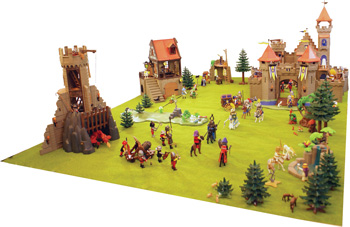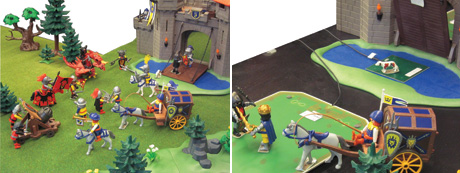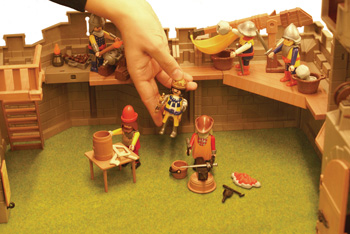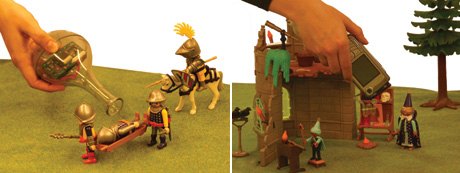by Steve Hinske and Matthias Lampe
Enhancing traditional toys with pervasive computing technology yields a mixed-reality platform that combines the best of the real and virtual worlds. Such augmented toy environments can be used in providing multimedia and educational content to children to increase the entertainment value on the one hand and, on the other, to playfully support informal learning.
Playing is an essential part of childhood: besides being a recreational amusement, it also serves as an important function for the psychological, physiological and social development of a child. Children learn about themselves and the world and people around them; they develop and improve manifold and important skills, such as social competence, problem-solving and creativity.
In contrast to traditional games, computer and video games typically fall far short in providing physical and social challenges. Children sit isolated in front of a computer screen, completely absorbed by virtual worlds and detached from the real world for many hours. Due to the interactive nature of video games however, gameplay itself can offer immersive designs and mental challenges that constantly adapt to the players skills, something not possible with traditional games.
Combining these two worlds - the real world and the virtual world, traditional games and interactive computer games - yields an interesting symbiosis that might prove very beneficial for children. The amalgamation of tangible sensation and virtual content with their own imaginations results in a thrilling entertainment experience for children. Adding virtual reality furthermore enables the integration of interactive educational content that can foster informal learning in a playful way.
Augmented toy environments try to achieve this promising though not trivial goal. By using pervasive computing technology (ie embedded computing devices, miniature sensors and wireless communication technology), traditional play artefacts can be seamlessly connected to virtual content, resulting in a mixed-reality environment that offers many attractive possibilities, especially for educational toys.
We have developed the Augmented Knights Castle (AKC), an augmented toy environment that enriches childrens pretend play by using background music, sound effects and verbal commentary of toys as well as different forms of tactile and visual feedback that react to the childrens play (see Figure 1). Moreover, interactive learning experiences can be integrated into the play; for example, teaching songs and poems or providing facts about the Middle Ages.


By using radio frequency identification (RFID) technology, the AKC is able to automatically and unobtrusively identify the play objects. Numerous RFID antennae are invisibly incorporated into the environment and certain play objects (eg the carriage) are equipped with mobile antennae (see Figure 2). Based on the aggregated data gathered by the antennae, the sounds and commentaries are played accordingly (eg the dragon roars when leaving its dungeon). This awareness of location is also exploited by the learning component: the king, for example, describes his life in the castle or explains different coats of arms to the children, depending on where he is currently located (see Figure 3).

To provoke further interaction, mobile phones and smart toys (eg a bottle with magic potion that is equipped with an RFID reader and an acceleration sensor) can be integrated into the play set (see Figure 4). Children can use the mobile devices to touch pieces of the augmented toy environment either as part of a learning scenario, a story that then unfolds, or simply as part of free play. While in the case of smart toys the feedback is tactile and auditory, the mobile phones can also play videos, which is especially beneficial for conveying educational content.

We chose the Playmobil Knights' Castle since it is a realistic image of the medieval world and provides an interesting and exciting environment for children. Additionally, the topic of the Middle Ages offers many anchor points for learning scenarios (eg music, clothing, troubadour literature, chivalry, heraldry, or knights tournaments). Based on their physical appearance, designated play figures will tell the children about the different aspects of medieval life: the troubadour teaches songs and poems, the blacksmith talks about how weapons and armour are forged, and the alchemist is a master of chemistry and physics. The AKC can even support the learning of foreign languages: by simply changing the language flag, the entire environment will 'speak' to children in another language.
Assuming that the trend of constant miniaturization and steadily increasing sensing and computing power will continue, augmented toy environments like the Augmented Knights Castle are likely to enter the commercial market in the near future. By superimposing a virtual layer on traditional toys, such play sets are likely to increase the entertainment value of childrens play without neglecting the physical and social experience. In addition, augmented toy environments can provide educational content in a playful and adaptable way with regard to individual preferences and needs. For these reasons, this new form of interactive mixed-reality entertainment may have an influence on how children play that is of similar significance to the emergence of computer games in the 80s.
Please contact:
Steve Hinske
Institute for Pervasive Computing, ETH Zurich
Tel: +41 44 632 0768
E-mail: steve.hinske![]() inf.ethz.ch
inf.ethz.ch
Matthias Lampe
Institute for Pervasive Computing, ETH Zurich
Tel: +41 44 632 7123
E-mail: lampe![]() inf.ethz.ch
inf.ethz.ch










